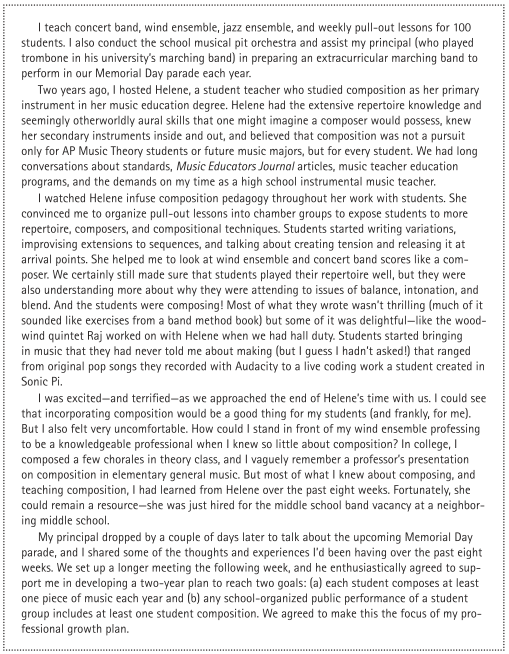Setting the Stage: A Hypothetical Context for Advancing Composition Pedagogy
I provide a hypothetical scenario (Figure 41.1) informed by my own experiences as a high school instrumental music teacher. If you work in other teaching settings (e.g., elementary general music, middle school choir, secondary general music), I invite you to make transfers from my experiences to yours.
A teacher in this situation might begin with familiar and available resources, such as Understanding By Design (Wiggins & McTighe, 2005). Wiggins and McTighe (2011) suggest considering three stages of backward design: Stage 1 (Identify desired results), Stage 2 (Determine acceptable evidence), and Stage 3 (Plan learning experiences and instruction accordingly). These sequential stages help teachers avoid “the all-too- common ‘twin sins’ of planning and teaching”: activity-oriented teaching and content coverage (2011, pp. 8-9). Further, this line of thinking positions composition centrally, beyond an activity that takes place in a particular class period or a topic that is “covered” through a lecture about compositional process or a particular composer’s background.
By conceptually avoiding these “twin sins,” composition becomes part of an important artistic process (i.e., creating) that also draws on, and develops connections with, skills and knowledge related to performing, responding, and connecting. This approach would align with four processes and 11 anchor standards in National Core Arts Standards for Music (State Education Agency Directors of Arts Education, 2014). These core arts standards also include enduring understandings and essential questions inspired by Understanding by Design (Wiggins & McTighe, 2005) that may be useful in planning instruction

Figure 41.1. A hypothetical teaching scenario
What might be a desired result for high school instrumental music students with respect to composition? Your state’s standards for music education or your school district curriculum may offer some helpful guidance, but desired results you specify will likely be unique based on student interests and background, available resources, and your experience with composition and composition pedagogy. I suggest specifying results that engage and challenge your students, and that leave you as the teacher feeling “uncomfortable but not paralyzed” (McClurken, 2010). Since composition is a practice underemphasized in many music teachers’ pre-service education, expanding and enhancing composition pedagogy provides opportunities to model a growth mindset while facilitating composing opportunities for students. After identifying desired results, you might consider acceptable forms of evidence—and then begin planning learning experiences and instruction accordingly.
In the hypothetical situation described above, I identified two desired results: (a) each student composes at least one piece of music each year and (b) any school-organized public performance of a student group includes at least one student composition. Acceptable forms of evidence for these results might include (but are not limited to) scores and recordings (result a) or concert programs or recordings (result b), alongside other performing, responding, and connecting outcomes.
As I worked toward this two-year goal, I would improve my pedagogy and student outcomes using teacher assessment and program evaluation processes. In the following sections, I will describe existing frameworks for each, and offer suggestions for expanding and modifying these models. These ideas are intended to be applicable not only for music teacher assessment and music program evaluation, but also for reflecting on and improving one’s pedagogy. That is, a teacher who is intentional about setting composition-related goals will consider metrics by which students’ achievement will be measured, specific skills and knowledge students should develop, and specific learning experiences in which students will engage.
Date added: 2025-04-23; views: 228;
